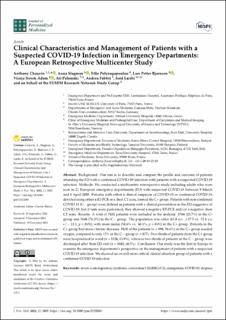| dc.contributor.author | Chauvin, Anthony | |
| dc.contributor.author | Slagman, Anna | |
| dc.contributor.author | Polyzogopoulou, Effie | |
| dc.contributor.author | Bjørnsen, Lars Petter Bache-Wiig | |
| dc.contributor.author | Adam, Visnja Nesek | |
| dc.contributor.author | Palomäki, Ari | |
| dc.contributor.author | Fabbri, Andrea | |
| dc.contributor.author | Laribi, Said | |
| dc.date.accessioned | 2023-02-13T09:49:38Z | |
| dc.date.available | 2023-02-13T09:49:38Z | |
| dc.date.created | 2023-01-10T10:47:11Z | |
| dc.date.issued | 2022 | |
| dc.identifier.citation | Journal of Personalized Medicine. 2022, 12 (12), . | en_US |
| dc.identifier.uri | https://hdl.handle.net/11250/3050281 | |
| dc.description.abstract | Background: Our aim is to describe and compare the profile and outcome of patients attending the ED with a confirmed COVID-19 infection with patients with a suspected COVID-19 infection. Methods: We conducted a multicentric retrospective study including adults who were seen in 21 European emergency departments (ED) with suspected COVID-19 between 9 March and 8 April 2020. Patients with either a clinical suspicion of COVID-19 or confirmed COVID-19, detected using either a RT-PCR or a chest CT scan, formed the C+ group. Patients with non-confirmed COVID-19 (C− group) were defined as patients with a clinical presentation in the ED suggestive of COVID-19, but if tests were performed, they showed a negative RT-PCR and/or a negative chest CT scan. Results: A total of 7432 patients were included in the analysis: 1764 (23.7%) in the C+ group and 5668 (76.3%) in the C− group. The population was older (63.8 y.o. ±17.5 vs. 51.8 y.o. +/− 21.1, p < 0.01), with more males (54.6% vs. 46.1%, p < 0.01) in the C+ group. Patients in the C+ group had more chronic diseases. Half of the patients (n = 998, 56.6%) in the C+ group needed oxygen, compared to only 15% in the C− group (n = 877). Two-thirds of patients from the C+ group were hospitalized in ward (n = 1128, 63.9%), whereas two-thirds of patients in the C− group were discharged after their ED visit (n = 3883, 68.5%). Conclusion: Our study was the first in Europe to examine the emergency department’s perspective on the management of patients with a suspected COVID-19 infection. We showed an overall more critical clinical situation group of patients with a confirmed COVID-19 infection. | en_US |
| dc.language.iso | eng | en_US |
| dc.publisher | MDPI | en_US |
| dc.rights | Navngivelse 4.0 Internasjonal | * |
| dc.rights.uri | http://creativecommons.org/licenses/by/4.0/deed.no | * |
| dc.title | Clinical Characteristics and Management of Patients with a Suspected COVID-19 Infection in Emergency Departments: A European Retrospective Multicenter Study | en_US |
| dc.title.alternative | Clinical Characteristics and Management of Patients with a Suspected COVID-19 Infection in Emergency Departments: A European Retrospective Multicenter Study | en_US |
| dc.type | Peer reviewed | en_US |
| dc.type | Journal article | en_US |
| dc.description.version | publishedVersion | en_US |
| dc.source.pagenumber | 0 | en_US |
| dc.source.volume | 12 | en_US |
| dc.source.journal | Journal of Personalized Medicine | en_US |
| dc.source.issue | 12 | en_US |
| dc.identifier.doi | 10.3390/jpm12122085 | |
| dc.identifier.cristin | 2103858 | |
| cristin.ispublished | true | |
| cristin.fulltext | original | |
| cristin.qualitycode | 1 | |

